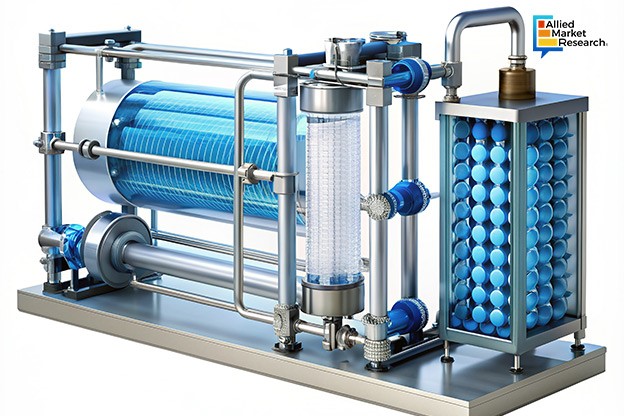Hydrogen Membranes: Novel Innovations and Technologies Redefining the Sector

3 Feb
2025
Highlights:
- Introduction
- Impact of the EV revolution on the industry
- Ingenious product launches in the sector
Since the 1992 Rio Earth Summit, awareness regarding environmental sustainability has increased drastically. Many new international treaties and agreements have been signed by developed and developing nations that seek to reduce the dependence on fossil fuels such as coal, oil, diesel, and petroleum. Countries like the US, China, India, the UK, Germany, etc., have even declared their intention to achieve net zero carbon emissions by the second half of the current century. To accomplish these goals, these sovereign states have enacted laws and norms that mandate the use of technologies that have minimal impact on the environment. Studies have shown that sectors like automotive and transportation, construction and manufacturing, and consumer goods are some of the most polluting industries.
Naturally, the focus of major players operating in these industries is to adopt innovations that reduce the carbon footprint of their business operations and decarbonize the sector in general. Hydrogen membrane technology is one such technology that has recently gained significant recognition for its role in advancing clean energy and supporting the transition to a green economy.
The rise of electric mobility helping the industry flourish
Hydrogen membranes are designed to separate hydrogen from air mixture, thus helping create a pure stream of the gas. The automotive and transportation sector has been one of the biggest users of this technology in recent times due to the emergence of electric and hybrid vehicles. These modern automobiles like fuel cell electric vehicles (FCEVs) require a continuous supply of hydrogen to run efficiently. Traditionally, the most common method to produce oxygen has been combustion which generates hydrogen along with polluting gases such as carbon dioxide and carbon monoxide.
To deal with this challenge, energy companies have developed advanced hydrogen separation technologies such as palladium-based membranes. These membranes work on the principles of water gas shifting and steam forming which assist in the generation of uncontaminated hydrogen. The high permeability offered by palladium-based separators aids in providing a steady stream of hydrogen necessary for developing vehicle fuel cells. Along with this, polymer-based membranes are also being designed that have the capacity to generate large volumes of hydrogen for high-end applications. For this purpose, polymers such as polyethersulfone, polycarbonate, polysulfone, polyamide, polyvinylidene fluoride, etc., are used. The main advantage of this innovative system is that it helps separate gases at the micron level, thus enabling users to generate the purest hydrogen.
Rising investments from leading energy companies impacting the industry positively
Over the years, many energy generation companies have invested heavily in the hydrogen membrane industry as part of their business expansion strategies. In April 2021, for instance, TECNALIA, a European research and development center, announced a partnership with H2SITE, an energy equipment supplier. Both these companies jointly unveiled the first-ever industrial-scale membrane reactor to produce hydrogen using various raw materials such as bioethanol, biomethanol, ammonia, etc. The press release issued by the companies highlighted that the main aim behind establishing this industrial facility was to provide green hydrogen to small and medium-scale energy companies.
Similarly, in May 2021, Agfa-Gevaert Group, a medical imaging company, developed a novel hydrogen membrane technology, Zirfon UTP 220. Designed to produce green hydrogen through a water electrolysis process, the product launch was termed by many industry experts as an important milestone in the industry. In 2022, Agfa-Gevaert Group even received the essenscia Innovation Award 2022 for this state-of-the-art technology.
Moreover, in March 2024, Ionomr Innovations Inc., a leading polymer membrane technology developer, announced the launch of iridium-free, catalyst-coated Aemion® Anion Exchange Membranes (AEMs) designed for low-cost green hydrogen production. This innovative system has been developed to generate H₂ gas which is free of any toxic perfluorinated substances. The company’s press release stated that the components and materials used in the technology are expected to bring down the cost of hydrogen production significantly, thus enabling power companies to develop green energy devices at lower rates.
In essence, the growth of the hydrogen membrane industry is attributed to the rising demand for hydrogen fuel from the automotive and energy sectors. The advent of electric and hybrid vehicles and the launch of innovative products by multinational giants are anticipated to create numerous growth opportunities in the market.
Get in touch with our experts for latest updates, upcoming trends, and technological advancements in the landscape of hydrogen membranes!

Akhilesh Prabhugaonkar
Author's Bio- Akhilesh Prabhugaonkar holds a bachelor’s degree in Electronics Engineering from the reputed Vishwakarma Institute of Technology. He has a special interest in the fields of forensics, world history, international relations and foreign policy, sports, agriculture, astronomy, security, and oceanography. An ardent bibliophile and melophile, Akhilesh loves to write on topics of his interest and various other societal issues. This love for writing made him enter the professional world of content writing and pursue his career in this direction.
Natural Rubber Industry: Nanotechnology and Sustainability Creating Promising Investment Opportunities
Avenue: Entire Library membership of Allied Market Research Reports at your disposal
- Avenue is an innovative subscription-based online report database.
- Avail an online access to the entire library of syndicated reports on more than 2,000 niche industries and company profiles on more than 12,000 firms across 11 domains.
- A cost-effective model tailored for entrepreneurs, investors, and students & researchers at universities.
- Request customizations, suggest new reports, and avail analyst support as per your requirements.
- Get an access to the library of reports at any time from any device and anywhere.
Related Post
-
How are Submarine Cables Transforming Global Connectivity with Enhanced User Experience?
-
Endoscopy Procedures: Transformations in Techniques and Applications
-
AI-Powered Video Analytics: How the Product Actually Works for enterprises
-
Painting Robots: Transforming Precision Coating and Creative Applications
-
Innovations in Pharmacovigilance Systems Advancing Patient Safety
-
Understanding Edge Security: Keeping Data Safe Near the Source
-
Exploring the Use and Advancements of 3D Laser Scanners in Professional Applications
-
Reinforcing Industrial Controls with Smarter Tools and Training








